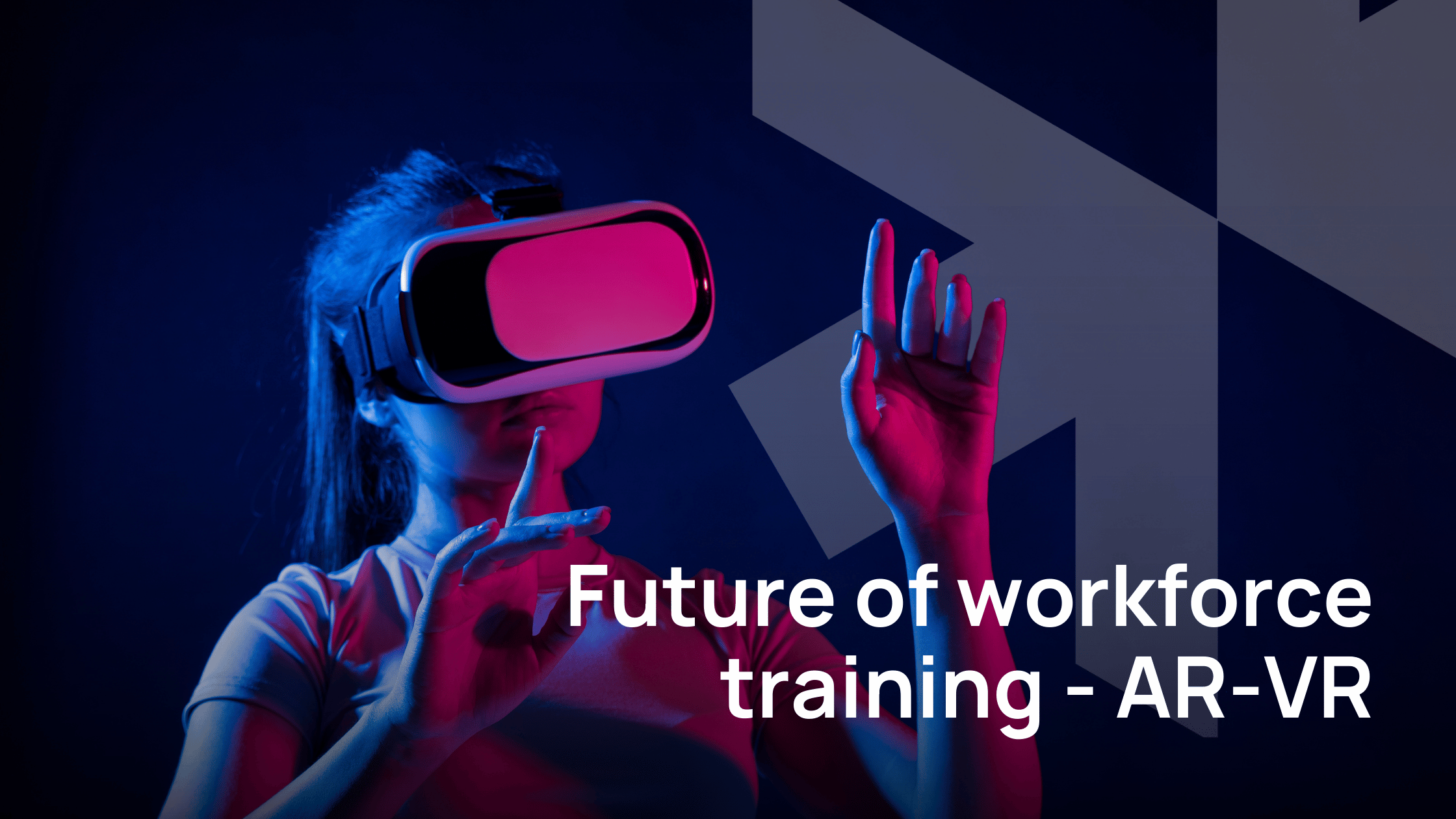As we advance into an era defined by rapid technological evolution, traditional training methodologies are increasingly falling short of industry demands. Industries such as automotive and life sciences are pioneering the use of augmented reality (AR) and virtual reality (VR) to revolutionize their training paradigms. These immersive technologies are not just enhancing the training experience; they are driving superior skill acquisition, bolstering safety protocols, and delivering significant cost efficiencies.
Imagine a scenario where a life sciences professional can practice intricate surgical procedures in a highly realistic virtual environment, or an automotive engineer can assemble an engine in a virtual workshop with unparalleled precision and feedback. These technologies provide a level of engagement and interaction that traditional methods simply cannot match.
This blog delves into how AR and VR are redefining workforce training. By examining real-world applications and projecting future innovations, we will illustrate how these advanced technologies are setting new benchmarks in training effectiveness.
Crafsol’s Innovative Approach with AR and VR
At Crafsol, we specialize in integrating AR and VR technologies into training programs to deliver exceptional learning experiences. Here’s how we make a difference:
- Immersive Learning Environments: By creating realistic and interactive virtual scenarios, we ensure that learners can practice and hone their skills in a safe and controlled setting. This immersive approach enhances engagement and retention.
- Remote Accessibility: With our AR and VR technologies, training can be accessed remotely, breaking down geographical barriers and allowing learners from different locations to participate in the same high-quality training programs.
- Customized Training Programs: We tailor our AR and VR solutions to meet the specific needs of each client, ensuring that the training content is relevant and directly applicable to their industry and workforce requirements.
- Data-Driven Insights: Our solutions include analytics and reporting features that track learner progress and performance. This data helps organizations identify areas for improvement and measure the effectiveness of their training programs.
By leveraging the latest advancements in AR and VR, Crafsol is committed to delivering cutting-edge training solutions that drive employee development and organizational success.
The Impact of VR in the Automotive Industry
Many car manufacturers, including Volkswagen, Audi, and BMW, are embracing virtual reality (VR) to revolutionize their training programs and overall operations. Here’s how VR is making a difference:
Key Applications:
- Training Programs: VR immerses trainees in realistic, three-dimensional environments, simulating real-world tasks and scenarios. This leads to better skill acquisition and a more engaging learning experience.
- Design and Prototyping: Companies like Volkswagen use VR to create detailed 3D models of vehicle designs. This allows engineers to visualize and test new concepts early in the development process, saving time and resources.
- Customer Experience:
- Virtual Showrooms: Brands like Kia and Vroom offer virtual showrooms, allowing customers to explore new and used cars from the comfort of their homes.
- VR Test Drives: Companies like Abarth provide potential buyers with VR test drives, enhancing the car shopping experience.
- Brand Story Tours: VR tours of brand histories and behind-the-scenes looks at production processes help build deeper connections with customers.
Market Growth:
- Current Value: $759.3 million in 2019
- Projected Growth: Expected to reach $14,727.9 million by 2027
Benefits of VR in Automotive:
- Efficiency: VR reduces the need for physical prototypes, which saves time and reduces costs.
- Enhanced Collaboration: Virtual environments facilitate better teamwork and communication, even across different locations.
- Cost Savings: By minimizing the need for physical materials and travel, VR significantly cuts down expenses.
- Innovation: VR allows for early testing and iterative design processes, leading to more innovative and customer-focused products.
Pandemic Influence:
The COVID-19 pandemic accelerated the adoption of VR, helping automotive companies maintain operations and customer engagement despite lockdowns and social distancing measures.
Future Outlook:
As VR technology continues to evolve, its applications in the automotive industry are set to expand further. From improving training programs to enhancing customer interactions, VR is poised to play a crucial role in shaping the future of car manufacturing and marketing.
AR & VR Global landscape
The global AR & VR market is on a trajectory of remarkable growth. In 2024, it is projected to generate US$40.4 billion in revenue. This market is expected to grow at a compound annual growth rate (CAGR) of 8.97% from 2024 to 2029, reaching a market volume of US$62.0 billion by 2029. The largest segment within this market is AR Software, anticipated to achieve a market volume of US$13.0 billion in 2024.
The United States is at the forefront, projected to lead with a market volume of US$10.9 billion in 2024. On a global scale, the number of AR & VR users is expected to reach 3.728 billion by 2029, with a user penetration rate projected to increase from 52.8% in 2024 to 56.5% by 2029. The average revenue per user (ARPU) is estimated to be US$11.9. Countries like China and the United States are leading in innovation and adoption, driving significant growth in the AR & VR landscape [source: Statista].
Future Prospects and Innovations in AR and VR Training
Emerging Trends in AR and VR
Haptic Feedback: The integration of haptic feedback in VR training modules is revolutionizing the training landscape by adding tactile sensations that enhance realism. This innovation allows users to feel textures, resistance, and vibrations, making the virtual experience more immersive and effective. For instance, in medical training, surgeons can practice procedures with realistic feedback, improving precision and confidence.
AI Integration: Artificial Intelligence (AI) is being incorporated into AR and VR platforms to create adaptive learning environments. AI algorithms analyze trainee performance and customize training modules to individual needs, providing personalized feedback and accelerating the learning process. This tailored approach is particularly beneficial in complex fields like medicine and engineering, where personalized training can significantly enhance skill acquisition.
Improved Accessibility: Advancements in AR and VR hardware and software are making these technologies more affordable and accessible. Cost-effective VR headsets and applications are now available on a variety of devices, broadening the reach of these technologies. This democratization of AR and VR is expected to drive widespread adoption across various industries, making advanced training tools accessible to more organizations.
Expanding Applications
Remote Collaboration: AR and VR are transforming remote collaboration by creating virtual spaces where teams can interact in real-time. These environments facilitate seamless communication and teamwork, regardless of geographical boundaries. VR platforms enable virtual meetings, collaborative design sessions, and remote technical support, enhancing productivity and fostering innovation.
Simulation and Modeling: Industries such as aerospace and architecture are leveraging AR and VR for complex simulations and 3D modeling. These technologies allow for detailed visualization and testing of designs, reducing the need for physical prototypes and accelerating the development process. For example, architects can conduct virtual walkthroughs of buildings, enabling clients to experience designs before construction begins.
Healthcare Advances: The future of VR in healthcare is promising, with applications ranging from advanced surgical simulations to virtual therapy for mental health. VR is being used for exposure therapy, pain management, and rehabilitation, providing immersive experiences that enhance patient outcomes. These applications not only improve the quality of care but also offer new avenues for medical training and patient engagement.
Potential Challenges and Solutions
Technical Challenges: Current technical limitations of AR and VR include hardware constraints such as limited battery life and the need for high-performance computing. These challenges can hinder the seamless integration of AR and VR into training programs. However, advancements in hardware technology, such as more efficient processors and longer-lasting batteries, are addressing these issues and paving the way for more robust VR systems.
Adoption Barriers: The widespread adoption of AR and VR technologies faces barriers such as high initial costs, the need for specialized training, and resistance to change. To overcome these challenges, companies are developing scalable training programs and cloud-based VR services that lower the entry barrier and make it easier for organizations to adopt these technologies.
Innovative Solutions: Innovative solutions are being developed to overcome the challenges of AR and VR adoption. Cloud-based VR services allow for scalable and cost-effective deployment of VR training programs. Additionally, continuous advancements in software development are making AR and VR applications more user-friendly and accessible, facilitating wider adoption.
Conclusion
AR and VR technologies are set to revolutionize training across various industries. By enhancing skill development, improving safety, reducing costs, and providing a competitive edge, these technologies offer immense potential. As AR and VR continue to evolve, their applications will expand, bringing about innovative solutions that will shape the future of training and beyond. Embracing these advancements will not only enhance organizational capabilities but also position companies as leaders in their respective fields.
Explore the Future of Training with Crafsol
At Crafsol, we specialize in integrating cutting-edge AR and VR technologies into training programs tailored to your specific needs. Our expertise ensures a seamless transition and empowers your organization to leverage the full potential of digital transformation.
Ready to Transform Your Training Programs?
Contact us today to learn more about our AR and VR solutions and how we can help you stay ahead in the digital era. Book a free consultation and start your transformation journey with Crafsol.







